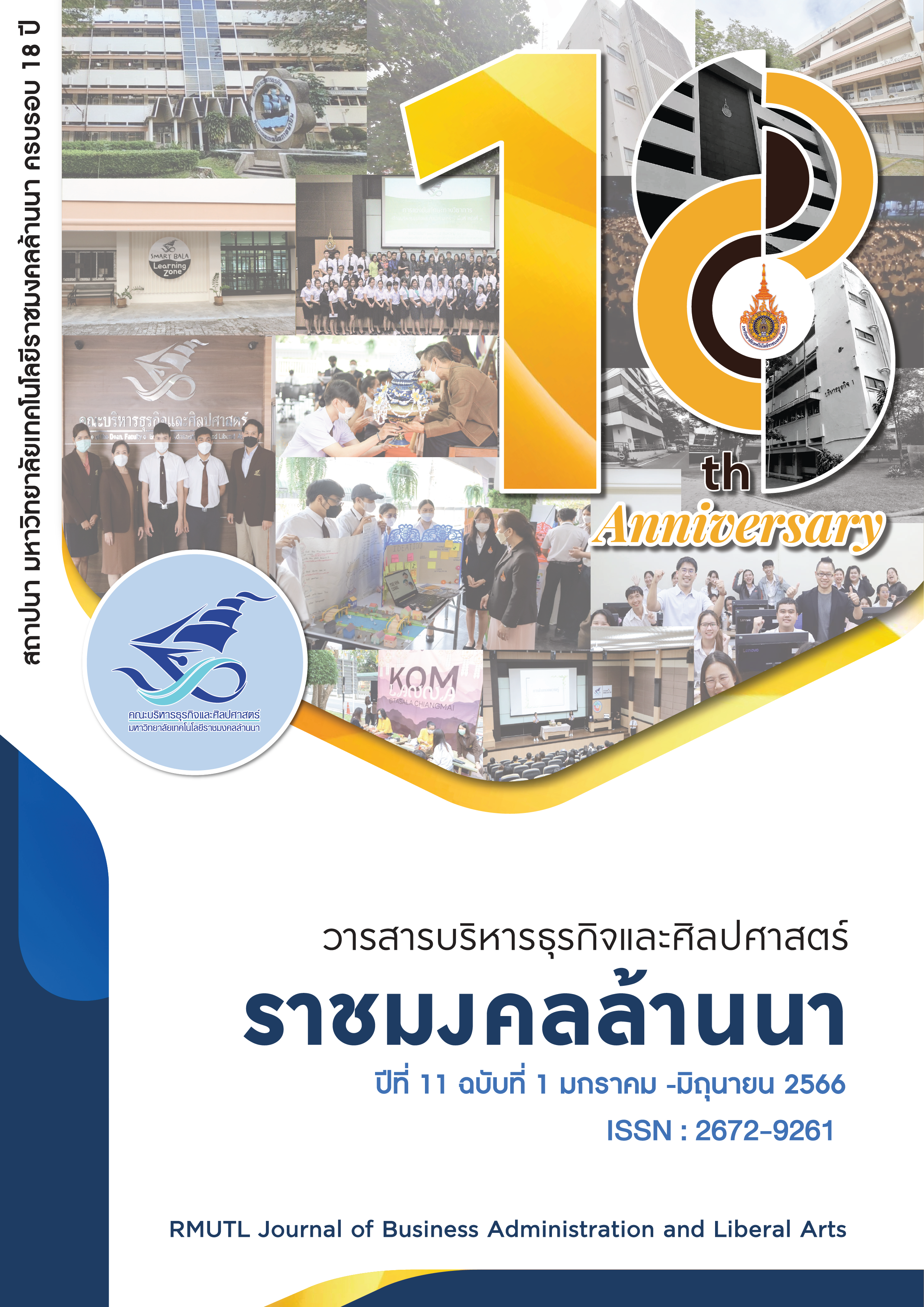Perception of Bachelor’s Degree Students Towards Brand Identity and Corporate Brand Engagement of Rajamangala University of Technology Lanna
Main Article Content
Abstract
The purpose of this quantitative research was to identify the perception towards brand identity and corporate brand engagement by testing the differences between them. The questionnaire was used to collect data from 388 samples which were senior students from three faculties of Rajamangala University of Technology Lanna. They were randomly selected. The data were analyzed by frequency, percentage, mean, standard deviation and One-Way ANOVA correlation analysis and Multiple Linear Regression analysis.
The research results were found that the majority of respondents were female (55.00%) and male (45.00%). Most of them were 22 years old (41.42%) They were drawn from the Faculty of Business Administration and Liberal Arts (48.52%), the Faculty of Engineering (37.84%) and the Faculty of Fine Arts and Architecture (13.61%), respectively. Finally, the results revealed that the respondents had a high level on perception toward overall brand identity and corporate brand engagement of Rajamangala University of Technology Lanna. The average level of each brand identity from highest to lowest level such as physical, brand relationship, brand reflection, brand characteristics, brand culture, brand perception, respectively. The average level of each corporate brand engagement from highest to lowest level such as brand pride, brand confidence, brand love, brand philanthropy, respectively. The six facets of brand identity were found to be influenced by respondents’ involvement with the brand as a consequence of the hypothesis testing. At the significant level of 0.05, brand engagement was significantly influenced by at least 1 variable of the brand’s identity.
Article Details

This work is licensed under a Creative Commons Attribution-NonCommercial-NoDerivatives 4.0 International License.
บทความวิจัยนี้เป็นของลิขสิทธิ์
References
กนกวรรณ ตาจันทร์, พิชญาภา อภิวันท์, ชิตาพัณณ์ บุญมาทอง และขจรศักดิ์ วงศ์วิราช. (2560). ปัจจัยการคงอยู่ของนักศึกษาระดับปริญญาตรีของมหาวิทยาลัยราชภัฏลำปาง. การประชุมวิชาการระดับชาติครั้งที่ 2 มหาวิทยาลัยเกษตรศาสตร์ วิทยาเขตศรีราชา: Innovation and creativity for Thailand 4.0, 31 ส.ค.-1 ก.ย. 2560, ชลบุรี
กรกาญจน์ ปานสุวรรณ, กนกอร คล้ายจันทร์, ชนิกานต์ เสือสิงห์, และนิตยา ศรีบัวรมย์. (2563). คุณภาพและอัตลักษณ์ของนิสิตตามการรับรู้ของผู้ใช้บัณฑิตที่สำเร็จการศึกษาจากคณะพยาบาลศาสตร์ มหาวิทยาลัยนเรศวร. วารสารการพยาบาลและสุขภาพ, 14(1), 54-65.
จุฑารัตน์ ทิพย์บุญทรัพย์ และศศิธร โรจน์สงคราม. (2560). การศึกษาความผูกพันของนักศึกษาต่อวิทยาลัยนานาชาติ มหาวิทยาลัยมหิดล. วารสาร Mahidol R2R e-Journal, 4(1), 56-69. Doi: 10.14456/jmu.217.5
บุญฑวรรณ วิงวอน. (2557). ความสัมพันธ์เชิงสาเหตุของมิติที่มีอิทธิพลต่ออัตลักษณ์ผ่านการรับรู้ความสามารถในตนของนักศึกษาคณะวิทยาการจัดการ มหาวิทยาลัยราชภัฏลำปาง. วารสาร มหาวิทยาลัยราชภัฏมหาสารคาม, 9(2), 119-132.
ปาจรีย์ หวังรุ่งกิจ สิทธิพงศ์ วัฒนานนท์สกุล และสิริวรรณ ศรีพหล. (2561). การพัฒนาตัวบ่งชี้คุณลักษณะความยึดมั่นผูกพันในวิชาการของนักศึกษาปริญญาตรี. วารสารวิชาการ มหาวิทยาลัยหอการค้าไทย. วารสารวิชาการ มหาวิทยาลัยหอการค้าไทย มนุษยศาสตร์และสังคมศาสตร์, 38(1), 71-89.
สุทธนู ศรีไสย์. (2551). สถิติประยุกต์สำหรับงานวิจัยทางสังคมศาสตร์. (พิมพ์ครั้งที่3). กรุงเทพฯ: คณะครุศาสตร์ จุฬาลงกรณ์มหาวิทยาลัย.
ไพศาล ฤทธิกุล. (2559). อัตลักษณ์และการรับรู้ภาพลักษณ์ที่ส่งผลต่อความจงรักภักดีของกลุ่มลูกค้าธนาคารต่างชาติ กรณีศึกษา ธนาคารไอซีบีซี (ไทย) จำกัด (มหาชน). (วิทยานิพนธ์บริหารธุรกิจมหาบัณฑิต). สงขลา: มหาวิทยาลัยสงขลานครินทร์.
พงษ์จันทร์ ภูษาพาณิชย์, วีรวรรณ วงศ์ปิ่นเพ็ชร์, ชูชัย สมิทธิไกร และพิมพ์ชนก เครือสุคนธ์. (2560). ปัจจัยพยากรณ์ความผูกพันของนักศึกษา มหาวิทยาลัยเชียงใหม่. (รายงานวิจัย). เชียงใหม่: มหาวิทยาลัยเชียงใหม่
พรทิพย์ ไชยฤกษ์. (2555). ความผูกพันต่อองค์กรและพฤติกรรมเชิงสร้างสรรค์ของบุคลากร สถาบันวิจัยแสงซินโครตรอน (องค์การมหาชน). วารสารเทคโนโลยีสุรนารี, 8(2), 61-69.
วีรพงษ์ พวงเล็ก, วสุพล ตรีโสภากุล, ณภัทรรัตน์ ไชยอัครกัลป์ และวีรวรรณ วงศ์ปิ่นเพ็ชร์. (2559). การศึกษาความสัมพันธ์การตระหนักรู้อัตลักษณ์ และการรับรู้ภาพลักษณ์มหาวิทยาลัยจากการเปิดรับสื่อเว็บไซต์ของนักเรียนระดับชั้นมัธยมศึกษาตอนปลาย. วารสารพฤติกรรมศาสตร์เพื่อการพัฒนา, 8(2), 115-132.
เหมันต์ พรหมสนธิ์ และสิทธิพงศ์ วัฒนานนท์สกุล (2563). อิทธิพลของการรับรู้บรรยากาศทางวิชาการที่มีต่อความผูกพันในการอ่านเชิงวิชาการในวัยรุ่นตอนปลายโดยมีเอกลักษณ์แห่งตน การรับรู้ความสามารถแห่งตนและการให้คุณค่าในการอ่านเป็นตัวแปรส่งผ่าน. วารสาร มจร สังคมศาสตร์ปริทรรศน์, 9(4), 229–244.
อารี บัวแพร, จุฑามาศ ชัยวรพร และศิวพร พิสิษฐ์ศักดิ์. (2559). ปัจจัยที่ส่งผลต่อความผูกพันของนักศึกษาระดับบัณฑิตศึกษา ต่อคณะเวชศาสตร์เขตร้อน มหาวิทยาลัยมหิดล. วารสาร Mahidol R2R e-Journal, 3(1), 124-144. DOI:10.14456/jmu.2016.10
Azoury, N. M., Daou, L. E., & EL Khoury, C. M. (2013). University image and its relationship to student satisfaction: case of the Holy Spirit University of Kaslik, Lebanon. Journal of Executive Education, 12(1), 1-13.
H. Cherif & Ben H. Miled. (2013). Are Brand Communities Influencing Brands through Co-creation? A Cross-National Example of the Brand AXE: In France and in Tunisia. International Business Research, 6(9), 14-29. DOI:10.5539/IBR.V6N9P14
Gallup Brand Marriage. (2004). Understanding employee engagement. Retrieved October 20, 2021, from http://www.frequentyasked.info/articles/?q=node/88
Henry Assael. (2004). Consumer Behavior: A Strategic Approach. Houghton Mifflin.
Kapferer, J. (2012). The New Strategic Brand Management: Advanced Insights and Strategic Thinking. India: Kogan Page.
Robbins, S. P. (2003). Organizational Behavior 10th Edition (tenth). Upper Saddle River, New Jersey: Pearson Education Inc.
John Martin, Chris Paola, Vitor Abreu, Jack Neal and Ben Sheets. (2009). Sequence stratigraphy of experimental strata under known conditions of differential subsidence and variable base level. AAPG Bulletin, 93(4), 503–533. DOI:10.1306/12110808057

